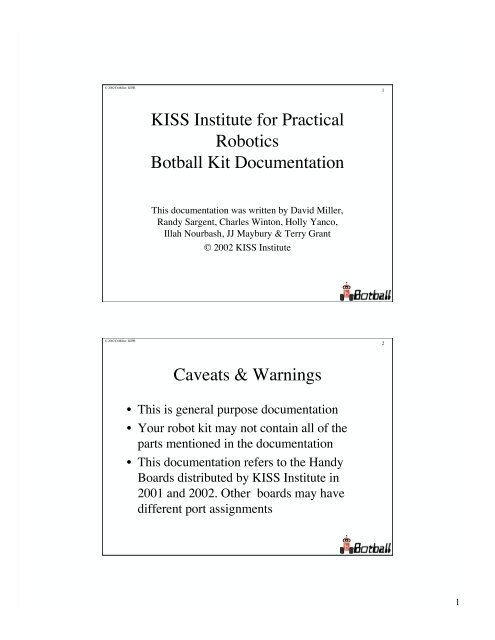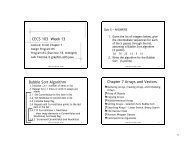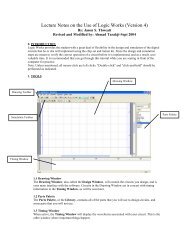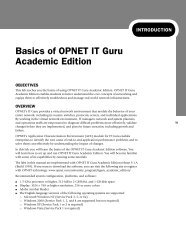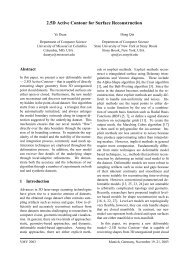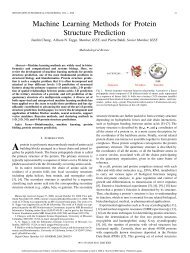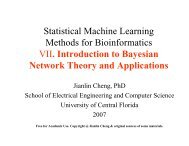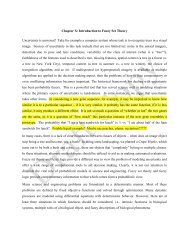Handyboard and Kit Manual (A.K.A. - Botball Programming Guide)
Handyboard and Kit Manual (A.K.A. - Botball Programming Guide)
Handyboard and Kit Manual (A.K.A. - Botball Programming Guide)
You also want an ePaper? Increase the reach of your titles
YUMPU automatically turns print PDFs into web optimized ePapers that Google loves.
© 2002 D.Miller, KIPR1KISS Institute for PracticalRobotics<strong>Botball</strong> <strong>Kit</strong> DocumentationThis documentation was written by David Miller,R<strong>and</strong>y Sargent, Charles Winton, Holly Yanco,Illah Nourbash, JJ Maybury & Terry Grant© 2002 KISS Institute© 2002 D.Miller, KIPR2Caveats & Warnings• This is general purpose documentation• Your robot kit may not contain all of theparts mentioned in the documentation• This documentation refers to the H<strong>and</strong>yBoards distributed by KISS Institute in2001 <strong>and</strong> 2002. Other boards may havedifferent port assignments1
© 2002 D.Miller, KIPR13Integer Arithmetic• + additionX + Y means X plus Y• - subtractionX - Y means X minus Y• * multiplicationX * Y means X multiplied by Y• / divisionX / Y means X divided by Y with the decimal truncated• % modulus (remainder)X % Y means the remainder of X divided by Y© 2002 D.Miller, KIPR14Floating Point Arithmetic• +,-,* operate the same as with integers• / yields a floating point number• % is not defined with floating pointnumbers7
© 2002 D.Miller, KIPR15IC Interaction Environment• You can type C statements (<strong>and</strong> C blocks)in the interaction window• Pressing return will send that code to the ICinterpreter which executes the code on theH<strong>and</strong>y Board• This is a quick way to test things• Try it!© 2002 D.Miller, KIPR16Useful Function:sleep(seconds);• sleep() delays the function’s executionfor an amount of time equal to the numberof seconds (expressed as a float) given as anargument8
© 2002 D.Miller, KIPR17C Function: printf();• Takes a quoted string <strong>and</strong> prints it out– %d is used for an integer– %f is used for a float– \n starts next character back at upper left corner(or new line on terminal)– commas separate all arguments after the quotedstring© 2002 D.Miller, KIPR18More IC Library Functions• start_button();• stop_button();• knob();• beep();9
© 2002 D.Miller, KIPR19• Tools menuNew Features of IC 4.0– List functions– List global variables (e.g., servo0)– List loaded files• Settings– Huge font– Download firmware© 2002 D.Miller, KIPR20Recap: Data Types• int (16 bit integer number in IC)e.g. +/-32,767• float (32 bit floating point number)e.g. 3.1416• <strong>and</strong> others (see IC documentation)10
© 2002 D.Miller, KIPR21Variables• Retain data for later use• Use in constructions such as arithmetic expressions• Must be declared before use at start of function (localvariables) or outside any function (global variables)– Syntax: – int i; [integer variable]– float x; [floating point variable]• To put a value in a variable:– Syntax: = – i = 2;– x = 2.0 * 1.5;– x = 3.2 * (float)i;© 2002 D.Miller, KIPR22Program Flow• When a program is run, the control moves fromone statement to the next• Be careful of 1 vs l (one vs ell)• Calculate j 2 + 1 when j = 3void main(){int r,j; /* declare r <strong>and</strong> j */j = 3; /* assign a value to j */r = j*j + 1; /* calculate <strong>and</strong> assign */printf(“result is %d\n”,r);}11
© 2002 D.Miller, KIPR23Repeating Execution: Loops• Loops are used when you want to do thesame thing multiple times• E.g., beep 20 times• You could type beep(); 20 times, butthere is a better way: a loop© 2002 D.Miller, KIPR24Repetition Using while• Syntax: while () {statements}• Beep 20 timesvoid main(){int num; /* declare counter */num = 1; /* initialize counter */while (num
© 2002 D.Miller, KIPR25IC: while ()• Syntax recap: while () {statements}void main(){int j=0; /* to tell how many times around the loop */while(stop_button()==0){j=j+1; /* next time around */printf(“loop %d - press stop to stop\n”,j);fd(0); /* turn on motor 0*/fd(2); /* turn on motor 2 */sleep(1.0); /* wait for 1 second */bk(0); bk(2); /* reverse both motors */sleep(1.0); /* wait for 1 second */}ao(); /* turn off all the motors */}© 2002 D.Miller, KIPR26Boolean Expressions• Boolean expressions result in either 1 (true) or 0(false)• Boolean operators:== (two equals signs together, not one)=!= (not equal)|| (or), && (<strong>and</strong>)! not• Already seen a boolean expression in while:– while ()13
© 2002 D.Miller, KIPR27Making a Decision with if• Syntax if () {statements}• The statements are skipped if the test isfalsevoid main(){int j=-2;if (j < 0) /* skip if >= 0 */{j = -j; /* change sign of x */}printf(“magnitude is %d\n”,j);}© 2002 D.Miller, KIPR28Either/Or Selection: if-else• Syntax if () {statements for true case} else {statements for false case}• If the test is true {statements for true case} are selected• If the test is false {statements for false case} are selectedvoid main(){int j=-2;if (j < 0) /* select less than 0 case */{printf(“%d is negative\n”,j);}else /* select greater than or equal to 0 case */{printf(“%d is non-negative\n”,j);}}14
© 2002 D.Miller, KIPR29IC: if () … else• Syntax recap: if () { …} else { …}void main(){if(digital(15)==1) /* select “forward” case */{motor(3,50);printf(“Forward\n”);}else /* select “reverse” case */}{motor(3,-75);printf(“Reverse\n”);}sleep(2.0); /* let motor run 2 secs */off(3); /* stop motor */© 2002 D.Miller, KIPR30IC: Selection Nested in Loopvoid main(){while (stop_button()==0) /* loop until stop */{if(digital(15)==1) /* select “forward” case */{motor(3,50);printf(“Forward\n”);}else /* select “reverse” case */{motor(3,-75);printf(“Reverse\n”);}sleep(2.0); /* let motor run for 2 secs */}off(3); /* turn off motor */}Teaser: what happens if you press <strong>and</strong> release stop while it is sleeping?15
© 2002 D.Miller, KIPR31IC: Functions & Processes• Functions are called sequentially• Processes can be run simultaneouslystart_process(function-call);– processes halt when function exits or parent processexits– processes can be halted by usingkill_process(process_id);• hog_processor(); locks process in CPUuntil it finishes or defers• defer(); causes process to give up the rest ofits time slice until next time.© 2002 D.Miller, KIPR32Example of Processesvoid main(){int pid;/* run my waa function *//* as a parallel process */pid=start_process(waa());sleep(5.0);/* if waa is still going *//* turn waa off */kill_process(pid);/* if tone got killed *//* finish it off */beeper_off();}void waa(){float p;while(!stop_button()){ /* run tone up *//* over & over */p=200.0;while(p
© 2002 D.Miller, KIPR33Example of Processes (2)void main(){int pid;// run s_waa function// as a parallel processpid=start_process(s_waa());sleep(10.0);/* if s_waa is still goingturn s_waa off */kill_process(pid);/* if s_waa timed out, turnoff sound & servo*/beeper_off();init_expbd_servos(0);}void s_waa(){float p;int s3; // servo valueinit_expbd_servos(1);while(!stop_button()){// run tone <strong>and</strong> servo upp=200.0; s3=200;while(p
© 2002 D.Miller, KIPR35IC <strong>Programming</strong>• The previous slides were just hilights– IC h<strong>and</strong>les most of ANSI C language includingmulti dimensional arrays, structs, #define, for,etc.– See a C text for more details of the C language– Use the Tools menu to see a list of all of the Cfunctions in the library© 2002 D.Miller, KIPR36H<strong>and</strong>y Board Checklist• H<strong>and</strong>y Board– Display– Expansion Board– Main Board– Battery Box• HB to Interface cable (phone cord)• Interface Board• Computer to Interface cable (25 pin to 9 pin)• AC Adapter (note: ground center, +12 outside)18
© 2002 D.Miller, KIPR37H<strong>and</strong>y Board Setup© 2002 D.Miller, KIPR38The H<strong>and</strong>y BoardoffPower switchonsonar red portdownload connectorMotor Ports (3 pins ea)Servo portsB|R|Y wiresCharge port(under exp board)knob (underexp board)floating analogports 16-19start <strong>and</strong> stop buttonslo-battleddigitalports7-15power ledoff in download modeanalogports2-6IR receiveranalogports20-2319
© 2002 D.Miller, KIPR39Sensor Types• Digital:– Return a 0 or a 1– Switches or bumpers are an example(open: 0, or closed: 1)• Analog:– Sensor returns a continuum of values– Processor digitizes results (8 bits give values of 0-255)– e.g. light sensors© 2002 D.Miller, KIPR40H<strong>and</strong>y Board Sensors• Knob• Start <strong>and</strong> Stop Buttons• light sensors: analog• IR reflectance sensors: analog• Optical rangefinder: floating analog• assorted touch sensors: digital• Slotted encoder sensors: digital• Sonar rangefinder: (special ports)• All detachable H<strong>and</strong>y Board sensorshave keyed connector20
© 2002 D.Miller, KIPR41Built-in Sensors: Knob• Knob: the knob is a potentiometer which istreated like an analog sensor– The access function knob() returns 0-255– Can be used for adjusting values during runtime© 2002 D.Miller, KIPR42• Start Button:Built-in Sensors: Start– Access function start_button()returns 1while pressed, 0 otherwise– Holding down Start while powering the boardwill bypass executing main (e.g., if yourprogram immediately causes the robot to move,<strong>and</strong> you want to download new code, this isvery useful)21
© 2002 D.Miller, KIPR43• Stop Button:Built-in Sensors: Stop– Access function stop_button()returns 1while pressed, 0 otherwise– Holding down Stop while powering the boardwill put the board in download mode. This isnecessary for loading the firmware.© 2002 D.Miller, KIPR44Light Sensors• Analog sensor• Connect to ports 2-6 or 20-23• Access with function analog(port#)• Low values indicate bright light• High values indicate low light• Sensor is somewhat directional <strong>and</strong> can be mademore so using black paper or tape or an opaquestraw or lego to shade extraneous light. Sensorcan be attenuated by placing paper in front.22
© 2002 D.Miller, KIPR45IR Reflectance Sensor “Top Hat”• Analog sensor• Connect to ports 2-6 or 20-23• Access with function analog(port#)• Low values indicate bright light, lightcolor, or close proximity• High values indicate low light, darkcolor, or distance of several inches• Sensor has a reflectance range of about 3inches© 2002 D.Miller, KIPR46IR Reflectance Sensors23
© 2002 D.Miller, KIPR47Optical Rangefinder “ET”• Floating analog sensor• Connect to ports 16-19• Access with functionanalog(port#)• Low values indicate large distance• High values indicate distanceapproaching ~4 inches• Range is 4-30 inches. Result isapprox 1/d 2 . Objects closer than 4inches will appear to be far away.© 2002 D.Miller, KIPR48Optical RangefinderPosition Sensing Device (PSD)LensLaser Beam24
© 2002 D.Miller, KIPR49Ultrasonic Rangefinder (Sonar)• Timed analog sensor• Connect red to Expansion board– (upper deck) port #0• Connect gray to Digital #7• Access with function sonar()• Returned value is distance in mm to closest object in fieldof view• Range is approximately 30-2000mm• No return (because objects are too close or too far) givesvalue of 32767• Wait at least .03 seconds between sonar()calls© 2002 D.Miller, KIPR50Ultrasonic Sensors• Puts out a short burst ofhigh frequency sound• Listens for the echo• Speed of sound is~300mm/ms• sonar() times the echo,divides by two <strong>and</strong>multiplies by speed ofsound• The sonar field of view isa 30 o teardropArea of coveragesonar25
© 2002 D.Miller, KIPR51• Digital sensor• Connect to ports 7-15• Access with functiondigital(port#)• 1 indicates switch is closed• 0 indicates switch is open• These make good bumpers<strong>and</strong> can be used for limitswitches on an actuatorTouch Sensors© 2002 D.Miller, KIPR52Slot Sensors• Digital sensor• Connect to ports 7-15• Access with functiondigital(port#)• 1 indicates slot is empty• 0 indicates slot is blocked• These can be used much liketouch sensors (if the object beingtouched fits in the slot)• Special abilities when used asencoders26
© 2002 D.Miller, KIPR53Using Encoders• Use the slot sensor (H<strong>and</strong>y Board only)• Connect to ports 7,8,12,13 (encoder# is0,1,2,3)enable_encoder(encoder#);– Only enable an encoder once...unless you disable it.disable_encoder(encoder#);read_encoder(encoder#);– returns the number of transitionsreset_encoder(encoder#);– sets that encoder to 0• Reflectance <strong>and</strong> slot sensors work best forencoders© 2002 D.Miller, KIPR54Mounting a slot sensor encoderCarefully alignsensor withencoder wheel27
© 2002 D.Miller, KIPR55Simple Encoder Programvoid main(){int enc1, enc0;enable_encoder(0); /* turn on the encoders */enable_encoder(1);while(!stop_button()){enc0=read_encoder(0); /* read each encoder */enc1=read_encoder(1); /* <strong>and</strong> show values */printf(“Enc0=%d Enc1=%d\n”,enc0, enc1);sleep(0.1); /* wait a bit <strong>and</strong> do it again */}}© 2002 D.Miller, KIPR56H<strong>and</strong>y Board DC Motors• All motors are connected to HBusing motor wire• Micro-motor slow gear motor• High-power gear motor(modified servo)• High speed gear motors28
© 2002 D.Miller, KIPR57H<strong>and</strong>y Board Servo Motors• When plugged in, black wire is on left,yellow on right• Enable Servos:init_expbd_servos(1);• Disable Servos:init_expbd_servos(0);• To change servo positions, change values of:servo0, servo1,…,servo5(these are examples of global variables)• Values should range between 100 <strong>and</strong> 3900• Note: Servos acting weird or not working isthe first sign of low battery© 2002 D.Miller, KIPR58Recharging <strong>Kit</strong> Batteries• H<strong>and</strong>y Boards should be charged through theinterface board– Interface board charging can be done in normal or Zapmode.• Normal charge lights yellow light on interface board whenworking, <strong>and</strong> does a trickle charge -- you can leave the boardcharging in this mode indefinitely. A full charge takes about 12hours, though you can use the board earlier.• ZAP fully charges in 2 hours, <strong>and</strong> will damage batteriesafter that. ONLY recommended while working with therobot with a dead battery or in tournament emergencies,29
© 2002 D.Miller, KIPRExperimenting With Motors <strong>and</strong>Sensors Using the IC InteractionWindow• Motorsfd(3);bk(3);off(3);motor(3,75); motor(2, -50);• Sensorsdigital(7);analog(6);sonar();59© 2002 D.Miller, KIPRTesting Your HB, Sensors &Motors• Download hbtest.ic (from the IC folder)• connect <strong>and</strong> test motors• connect <strong>and</strong> test servos (one at a time)• connect <strong>and</strong> test digital sensors• connect <strong>and</strong> test analog sensors (be sure you havethe right type of sensors in the right ports)• connect <strong>and</strong> test sonar sensor6030
© 2002 D.Miller, KIPR61Lego RCX• Simple controller– Similar memory <strong>and</strong> processor to H<strong>and</strong>y Board• Three sensor inputs• Three motor ports– Communicates to your computer via the IR tower– RCX powered by 6 alkaline AA batteries– IR tower powered by 9v alkaline battery– Gray DB9 to DB9 cable connects tower to serial port– Mac Serial port users, use HB cable, the 25-9 pinconnector <strong>and</strong> then the gray DB9-DB9 cable© 2002 D.Miller, KIPR62The RCX Controller• Your kit may also include a LEGO RCXcontroller• Use the “switch controller” menu item from the ICsettings menu to bring up the picture of the RCX<strong>and</strong> select it• If your RCX does not say IC 4 when you turn iton, then you will need to download the firmware31
© 2002 D.Miller, KIPR63RCX SetupTo your serial port© 2002 D.Miller, KIPR64RCX Ports• Ports 1, 2, & 3 are thesensor ports• Ports A, B & C are themotor ports (referredto in code as A, B & C(1, 2, & 3 also work)e.g., fd(A); orfd(1); turns on themotor on port A)32
© 2002 D.Miller, KIPR65RCX Buttons• Power button turns RCX On <strong>and</strong> Off• Run Button runs the main function(“crash appears on screen if no mainis loaded”)• View button displays sensors portvalues if program is NOT running• view_button() <strong>and</strong>prgm_button() --access fromyour program (like start & stop)© 2002 D.Miller, KIPR66Exposed connector means BadIR Tower BatteryGood• Be sure to insert the batteryall the way• Connectors fit into the leftwall• If your communication doesnot work, check battery33
© 2002 D.Miller, KIPR67RCX Cool Functions in IC• battery_volts() returns the level of the RCXbatteries• brake(n) stops motor n (e.g., 1, 2 or 3) quickly (morequickly than off(n) )• allbrake() same as above• light(p) returns value of light sensor, with emitter on,connected to port p• light_passive(p) returns value of light sensorconnected to port p• poweroff() turns off the RCX© 2002 D.Miller, KIPR68RCX functions in IC• RCX does not support…– analog(p)– math functions other than + - / *– sonar– servo functions, encoder functions• RCX supports very limited printf capabilities (%dworks; no %f; no \n ever needed in RCX; characters do notlook very good)34
© 2002 D.Miller, KIPR69RCX Sensors• The RCX can only use LEGO Mindstormssensors– Touch sensor use digital(port#)– Light sensor use light(port#)to getareflectance reading orlight_passive(port#)to get a passivelight reading© 2002 D.Miller, KIPR70A Simple LEGO Robot• The next several slides give step by stepassembly instructions for a simple robotchassis• This robot may be used with either the RCXor H<strong>and</strong>y Board controller (a few extrablocks will be needed to secure the HB tothe chassis)• The colors of your parts may vary35
© 2002 D.Miller, KIPR71© 2002 D.Miller, KIPR7236
© 2002 D.Miller, KIPR73© 2002 D.Miller, KIPR7437
© 2002 D.Miller, KIPR75© 2002 D.Miller, KIPR7638
© 2002 D.Miller, KIPR77© 2002 D.Miller, KIPR7839
© 2002 D.Miller, KIPR79© 2002 D.Miller, KIPR8040
© 2002 D.Miller, KIPR81© 2002 D.Miller, KIPR8241
© 2002 D.Miller, KIPR83© 2002 D.Miller, KIPR8442
© 2002 D.Miller, KIPR85© 2002 D.Miller, KIPR8643
© 2002 D.Miller, KIPR87© 2002 D.Miller, KIPR8844
© 2002 D.Miller, KIPR89A Simple Bumper45


